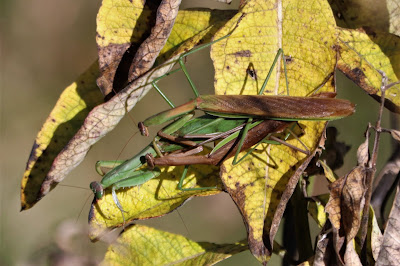Praying Mantises!
I found 3 different Praying Mantises this week. They go through incomplete metamorphosis. (egg, nymph, adult. There is no pupa stage.) When they hatch from the egg, they are miniature replicas of the parents. As they grow, they shed their exoskeleton 7 to 9 times before becoming an adult. They are easier to find in the fall because of their larger size.
Camouflage assists them in avoiding predators but also allows them to sneak up on prey. A well hidden praying mantis is in the centre of the photo.
Sometimes they are situated where they aren't as well hidden.
Update:
I published the above post first thing this morning then headed out for a walk. I wasn’t expecting to capture the following pictures with my camera! 2 male Praying Mantises vying to mate with the larger female! No, I didn’t wait to see if she would eat their heads. That behaviour tends to happen when they are under stress, such as when captive. I walked away and returned over an hour later to see the competition was still underway. 6 Praying Mantises in one week!







No comments:
Post a Comment